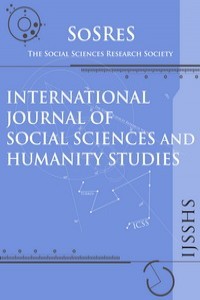EXPERIENCE-BASED ART EDUCATION: HOW PREJUDICES ABOUT CONTEMPORARY ART CAN LEAD TO ENRICHED EDUCATION IN MUSEUMS
EXPERIENCE-BASED ART EDUCATION: HOW PREJUDICES ABOUT CONTEMPORARY ART CAN LEAD TO ENRICHED EDUCATION IN MUSEUMS
___
- Arnheim, Rudolf (1969), Visual thinking, Berkeley: University of California Press.
- Beardsley, Monroe (1982), The aesthetic point of view, Ithaca: Cornell.
- Bourriaud, Nicholas (2002), Relational aesthetics, Paris: Press du Réel.
- Carroll, Noël (2002), “Aesthetic experience revisited”, British Journal of Aesthetics, No. 42, pp. 168.
- Charman, Helen and & Marc Ross (2006), “Contemporary art and the role of interpretation:
- Reflections from Tate Modern’s Summer Institute for Teachers”, The International Journal of Art & Design Education, No. 25, pp. 28-41. Collingwood, Robin George (1938), The principles of art, New York: Oxford University Press.
- Costantino, Tracie (2007), “Articulating aesthetic understanding through art making”,
- International Journal of Education & the Arts, No. 8. http://ijea.asu.edu/v8n1/, [Accessed 04.2007]
- Csikzentmihalyi, Mihaly and Rick Robinson (1990), The art of seeing: An interpretation of the aesthetic encounter, Malibu: The J. Paul Getty Trust.
- Danto, Arthur Coleman (1981), The transfiguration of the commonplace: A philosophy of art,
- Cambridge: Harvard University Press. Dewey, John (1958), Art as experience, (16ed.), New York: Capricorn Books (Original work published 1934). th
- Gadamer, Hans-Georg (2000), Wahrheit and Methode: Grundzüge einer Philosophischen
- Hermeneutik, (J. Weinsheimer & D.G. Marshall, Trans.) (2 Continuum (Original work published 1960). nd ed.) Truth and Method, New York:
- Glaser, Barney and Anselm Strauss (1967), The discovery of grounded theory, Chicago: Aldine.
- Gombrich, Ernst (1980), Art and Illusion: A Study in the Psychology of Pictoral Representation, Oxford: Phaidon;
- Gooding-Brown, Jane (2000), “Conversations about art: A disruptive model of interpretation”,
- Studies in Art Education, No. 42, pp. 36-50. Goodman, Nelson (1969), Languages of art: an approach to a theory of symbols, London: Oxford University Press.
- Kesner, Ladislav (2006), “The role of cognitive competence in the art museum experience”,
- Museum Management and Curatorship, No. 21, pp. 4-19. Matravers, Derek (1998), Art and Emotion, New York: Oxford University Press.
- Merleau-Ponty, Maurcie (1945), Phénoménologie de la Perception, Paris: Gallimard.
- Muhr, Thomas (1997), Atlas.ti for Windows, Berlin: Scientific Software Development.
- O’Neill, Marie-Claire and Colette Dufresne-Tassé (1997), “Looking in everyday Life / gazing in museums”, Museum Management and Curatorship, No. 16, pp. 131-142.
- Parsons, Michael (2002), “Aesthetic experience and the construction of meanings”, Journal of
- Aesthetic Education, No. 36, pp. 24-37. Page, Tara et al. (2006), “Teaching now with the living: A dialogue with teachers investigating contemporary art practices”, The International Journal of Art & Design Education, No. 25, pp. 155.
- Shusterman, Rechard (1997), “The art of aesthetic experience”, The Journal of Aesthetics and Art Criticism, No. 55, pp. 29-41.
- Stedelijk Museum voor Actuele Kunst (n.d.),Collection, http://www.smak.be/collectie_geschiedenis.php, [ Accessed 23.08.2006]
- Strauss, Anselm and Juliet Corbin (1994), Basics of qualitative research, London: Sage Publications.
- Van Moer, Eva (2007), “Talking about contemporary art: The formation of preconceptions during a museum visit”, The International Journal of the Arts in Society, No. 1, pp. 1-8.
- Başlangıç: 2009
- Yayıncı: Sosyal Bilimler Araştırmaları Derneği
E-LEARNING EDUCATION SYSTEM IN UNIVERSITIES WITH INSTRUCTORS’ PERSPECTIVES AND A SURVEY IN TURKEY
Fazli YILDIRIM, Oktay KORUCU, Ceyhan AKTAS, Gokce KULE
Hasan Huseyin TURAN, Nihat KASAP, Berna TEKTAS SİVRİKAYA
OLDER PEOPLE AND SPORT, LOOKING BEYOND THE HEALTH PERSPECTIVE
Eva VONCK, Dominique VERTÉ, Liesbeth De DONDER, Tine BUFFEL, Nico De WİTTE, Sarah DURY
RECRUITING OLDER VOLUNTEERS: FINDINGS FROM THE BELGIAN AGEING STUDIES
Sarah DURY, Dominique VERTÉ, Tine BUFFEL, Liesbeth De DONDER, Nico De WİTTE
İnge PLACKLÉ, Arno LİBOTTON, Nadine ENGELS, Gwendolyn HOTTON
REFLECTIONS ABOUT INTERVENTIONS AND STRATEGIES ON INCREASING FEELINGS OF SAFETY IN LATER LIFE
Liesbeth De DONDER, Dominique VERTÉ, Nico De WİTTE, Tine BUFFEL, Sarah DURY
LIFELONG LEARNING AS A STRATEGY FOR EDUCATING GLOBAL CITIZENS WITHIN HIGHER EDUCATION
Ele HOLVOET, Koen LOMBAERTS, Nadine ENGELS, Free De BACKER, Tom VANWİNG
Gábriel Györgyi TŐZSÉR, Szira ZOLTÁN
CARE SHORTAGES IN LATER LIFE: THE ROLE OF INDIVIDUAL AND CONTEXTUAL VARIABLES IN FLANDERS, BELGIUM
Nico De WİTTE, Tine BUFFEL, Liesbeth De DONDER, Sarah Dury, Dominique Verté
